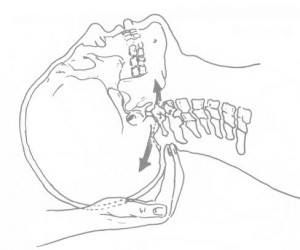A technique called craniosacral therapy has been noted as an alternative cancer treatment therapy by its practitioners and others. Craniosacral therapy entails light touches to the bones in a person’s skull, face, mouth, spine and pelvis with the goal of releasing tension in the body and improving body motion. These techniques were first developed in 1899 and have been used by osteopaths, chiropractors, massage therapists and others ever since. We will present further details on this type of therapy and discuss how it’s used as an alternative cancer therapy.
Supporters and practitioners of these techniques claim that the gentle pressure on the bones of the head, spine and pelvis can help to increase the flow of cerebrospinal fluid and help to cure or alleviate a number of ailments including cancer.

The practitioners of craniosacral therapy believe that there is a direct link between the fluid in the head and the sacrum which is located at the base of the lower back. The fluid which runs between these two areas has a pulse type rhythm and these techniques are designed to balance the rhythm and eliminate blockages which can help the body to operate in much better manner.
Some of the more notable benefits of craniosacral therapy include reductions in headaches, neck and back pain, relief of chronic fatigue syndrome, hyperactivity, severe depression, attention deficit syndrome and others.
It is claimed that the techniques improve the effectiveness of the immune system which can help to fight the threat of different types of cancer.
Keep in mind that while a number of practitioners and patients alike believe in the effectiveness of this therapeutic technique, there are no known studies which have proven the ability of craniosacral therapy as a cancer treatment.
As a matter of fact, the manner in which craniosacral therapy is supposed to occur is not consistent with our understanding of the anatomy and physical processes associated with the skull, brain and spinal fluid circulation. A number of well controlled and documented studies have been unable to confirm any direct benefit of the use of these techniques. Studies were done to a wide variety of patients ranging from children, women and men with no conclusive findings of positive results. Nevertheless a number of patients report very good success with these techniques.
And since it can be used as a natural stress treatment, and help to relieve stress and muscle strain, it can be of benefit in addressing undesirable side effects associated with traditional cancer treatments including nausea, stress, imbalance and fatigue.
It can therefore be a way for patients to achieve a better quality of life but should not necessarily be viewed as a cure.
Before considering this type of treatment, patients are advised to consult with their own doctor to make sure they would not suffer any problems through the manipulation of bones in their head and spine.
And it should never be relied upon to provide the only method of treatment for cancer. Otherwise it is the type of technique which should cause no harm and may in fact provide some relief.



